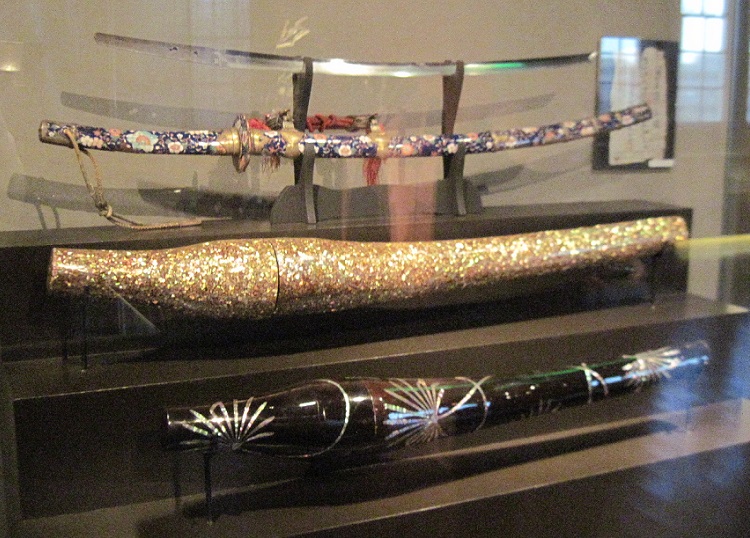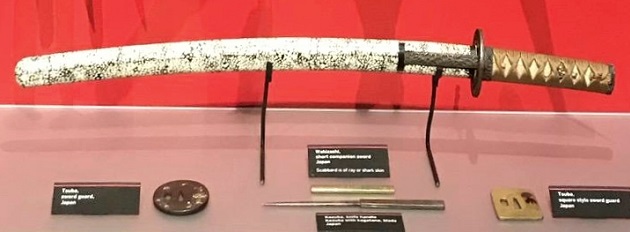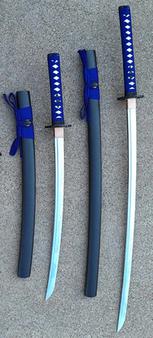Subject: 侍 samurai warrior
Culture: Japanese
Setting: Tokugawa shogunate, Japan 17th-mid 19thc
Object: 大小 daishō 'long/short' paired sabers = 刀 katana & 脇差 wakizashi
*
* Metropolitan Museum of Art > Stone Gallery of Arms and Armor
"Mounting for a Daishō Gold, shakudō, lacquer, wood and silk Edo period, 19th century"
"Sword Stand Lacquered wood, decorated in gold and silver Edo period, 18th century"
* Metropolitan Museum of Art > Stone Gallery of Arms and Armor
"[below] Mounting for a Katana Shakudō, gold lacquered wood, ray skin, silk
Meiji period, late 19th-early 20th century"
* Metropolitan Museum of Art > Stone Gallery of Arms and Armor
"Mounting for a Sword (Katana) Gold, shakudō, shibuichi, lacquered wood, coral, silver, ray skin, whalebone
Fittings inscribed by Kazunori (1824-1876) Edo period, 19th century"
* Metropolitan Museum of Art > Stone Gallery of Arms and Armor
"Blade for a Sword (Katana) Steel Inscribed by Tadahiro (second generation) Momoyama period, dated 1636"
"Mounting for a Katana Fittings of shakudō, gold, shibuichi; scabbard of lacquered wood; handle of wood, ray skin, silk
Edo period, late 18th-early 19th century"
* Metropolitan Museum of Art > Stone Gallery of Arms and Armor
"Blade for a Short Sword (Wakizashi) Steel Inscribed by Masatoshi Momoyama period, early 17th century"
"Mounting for Wakizashi Fittings of shakudō, gold, shibuichi; scabbard of lacquered wood; handle of wood, ray skin, silk
Edo period, late 18th-early 19th century"
* Metropolitan Museum of Art > Stone Gallery of Arms and Armor
"[below] Mounting for a Tachi
Silver, gold, leather, lacquered wood, textile
Edo period, 19th century"
Shuang Long *
* Metropolitan Museum of Art > Stone Gallery of Arms and Armor
"Sword Stand Lacquered wood Edo period, 19th century"
"Mounting for a Slung Sword (Tachi) Shakudō, gold, lacquered wood, ray skin, silk Fittings attributed to Gōtō Renjō (1628-1708) Edo Period, 17th century (scabbard, 19th century) The decoration of the sword guard (tsuba) and scabbard incorporates the apricot blossom badge of the Nabeshima family, daimyo of northern Kyushu."
*
* Royal Ontario Museum > Takamado Gallery of Japan
"Montage à Tachi (sabre suspendu) Bois laqué à décor maki-e en or, garnitures en argent
v. 1861, époque Edo
Le sabre tachi, commun entre le Xe et le XVe siècle, se portait suspendu par un cordon, le tranchant dirigé vers le bas. Le sabre katana (porté le tranchant vers le haut) supplanta le tachi à l'époque Edo (1603-1868). Le tachi devint alors un sabre de cérémonie.
"Ce petit tachi purrait avoir été fabriqué pour un jeune samourai de haut rang. Il est monté selon le style kenuki-gata, nommé ainsi en raison de ses ornements de poignée en forme de pincettes. ..."
*
* Metropolitan Museum of Art > Stone Gallery of Arms and Armor
* Tropenmuseum > Nederlands-Indië
* Metropolitan Museum of Art > Stone Gallery of Arms and Armor
* Mabee-Gerrer Museum of Art > Weapons and Warriors: The Art of Armaments
"Japanese Katana
metal, fabric,
c.1840 ...
This Katana with an early Choshu style tsuba, the plate guard of a Japanese sword, has a dragon motif."
* Mabee-Gerrer Museum of Art > Weapons and Warriors: The Art of Armaments
"Japanese Katana
metal, wood" ...
* Harwood International > Samurai Collection
"Tachi (sword) Late Edo period, 19th century Iron, enamel, silk cord, gold, leather ...
In popular imagination the sword is the most prominent symbol of the samurai. Japanese blades, with their perfect balance of strength and suppleness, are considered to be the finest in the world. They are made with reverent precision reminiscent of religious ceremony. In certain families, these techniques have been passed down for close to one thousand years.
"Katanazutsu (sword case) Mid Edo period, 18th century Wood, lacquer, mother-of-pearl ...
Katanazutsu (sword case) Mid Edo period, 18th century Wood, lacquer, mother-of-pearl ...
These ornate katanazutsu were used by high-ranking samurai to transport their sheathed swords. Both cases are encrusted with aogai wherein mother-of-pearl is incorporated into the lacquer."
* Peabody Museum of Archaeology and Ethnology > Arts of War
"Wakizashi, short companion sword Japan Scabbard is of ray or shark skin"
"Tsuba, sword guard, Japan"
"Kozuka, knife handle included with kogatana, knife Japan"
"Tsuba, square style sword guard Japan"
* Fort Worth Museum of Science and History > Transformation of Weaponry
"Katana Japan ca. 1670 Steel, Wood, Silk, and Manta Skin" ...
"Wakizashi Japan ca. 1670 Steel, Wood, Silk, and Manta Skin" ...
* Metropolitan Museum of Art > Stone Gallery of Arms and Armor
"Blade for a Short sword (Wakizashi)
Steel Inscribed by Tadayoshi (1st generation)
Edo period, 17th century" ...




